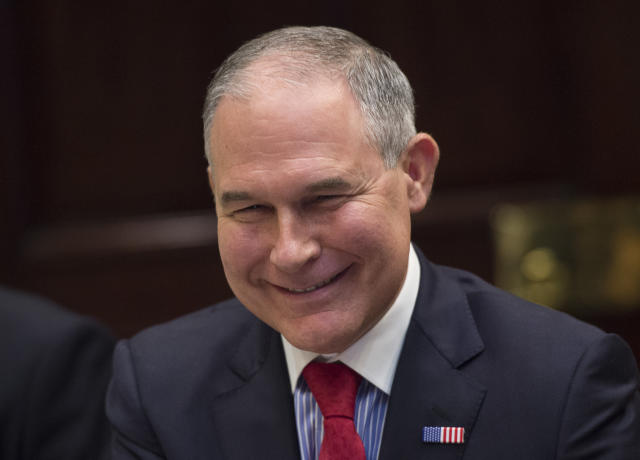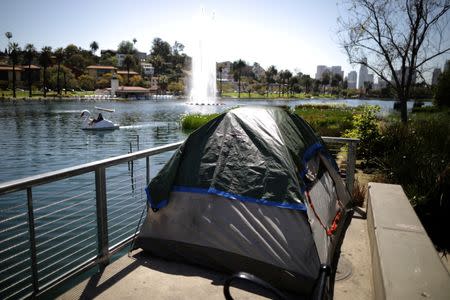Miami Herald
Advocates sue as coal plant pollution seeps into Illinois’ only national scenic river
By Michael Hawthorne, Chicago Tribune May 30, 2018

Chicago: The first sign of trouble on Illinois’ only national scenic river is when thick stands of sycamore, red bud and oak suddenly give way to a barren, rocky bank stained metallic hues of orange and purple.
Pools of rust-colored water stagnate along the edge of the Middle Fork of the Vermilion River as the otherwise clear, fast-moving stream meanders past the source of the unnatural phenomena: three unlined pits of coal ash dug into the floodplain by owners of a now-defunct power plant that generated enough toxic waste during the past half century to fill the Empire State Building nearly 2 1/2 times.
Internal reports prepared by Texas-based Dynegy Inc., the last owner of the former Vermilion Power Station, have shown the multicolored muck seeping into the river is concentrated with arsenic, chromium, lead, manganese and other heavy metals found in coal ash. State environmental regulators confirmed the findings more than a decade ago, yet pollution continues to ooze into the Middle Fork.
With the administrations of President Donald Trump and Illinois Gov. Bruce Rauner rolling back enforcement of national and state environmental laws, advocates are urging a federal court to step in and order Dynegy to take more aggressive action. Environmental groups fear that steady erosion of the riverbank could trigger a catastrophic spill, similar to disasters at coal plants in Tennessee and North Carolina where ash impoundments ruptured and caused millions of dollars in damage.
“Dynegy left a toxic mess on the banks of one of Illinois’ most beautiful rivers and has done nothing to stop the dangerous, illegal pollution from fouling waters enjoyed by countless families who kayak, tube, canoe and even swim in the river,” said Jenny Cassel, an attorney with Earthjustice, one of the nonprofit groups behind a lawsuit filed Wednesday that accuses Dynegy of violating the federal Clean Water Act.
The Middle Fork winds through east central Illinois amid corn and soybean fields and clusters of wind turbines rising above moraines that interrupt the flat farmland. About 17 miles of the river in Vermilion County are protected under the federal National Wild and Scenic Rivers Act, including the stretch that flows past the shuttered coal plant about a mile downstream from a popular canoe and kayak launch. The river and surrounding woods are home to dozens of endangered and threatened species, including bald eagles, bluebreast darters and several species of freshwater mussels.
 Smallies
Smallies
Last month another nonprofit group, American Rivers, cited the ongoing threats to recreation and aquatic life when it named the Middle Fork one of the nation’s most endangered waterways.
Dynegy consultants have estimated it could cost up to $192 million to transfer 3.3 million cubic feet of coal ash from the Vermilion plant to a licensed landfill. The company once suggested it could cap the waste pits to prevent rain and snowmelt from washing coal ash into the water, but another Dynegy report estimated the normal flow of the Middle Fork is eroding the river banks by up to 3 feet a year, making it more likely the toxic slurry will be exposed if left in place.
As Dynegy struggled to keep the rest of its Illinois coal plants operating in the downstate power market, it was absorbed in April by another Texas-based company, Vistra Energy, which reported earnings of $1.4 billion in 2017. Neither company responded to requests for comment about the lawsuit.
The Vermilion plant is one of two dozen sites in Illinois where energy companies have dumped coal ash for years. Most waste is stored close to rivers and lakes used for cooling water, and the Illinois Environmental Protection Agency considers 10 of the other sites to pose serious threats to the drinking water supplies of nearby communities.
Illinois Power, which built the Vermilion plant in 1955 and sold it to Dynegy in 2000, tried to prevent its ash pits from leaking during the 1980s by stacking rock-filled wire cages along the river. But torrents of high water during and after storms have washed away many of the protective formations, exposing steady trickles of pollution through fractured sandstone and shale.
During a trip down the river in early May, three advocates who frequently paddle the Middle Fork said the problems appeared significantly worse than what they saw last fall. Andrew Rehn, water resources engineer for the Prairie Rivers Network, the chief plaintiff in the federal lawsuit against Dynegy, said he has seen waste seeping from the riverbank every time he has been on the river during the past eight years.
“Over the years the utilities have used the floodplain as essentially a dumping ground,” said Lan Richart, a former Illinois Natural History Survey ecologist who along with his wife, Pam, formed another group pushing to protect the Middle Fork. “Now it’s been shown to be polluting both the groundwater and the river.”
 Smallies
Smallies
Because the Vermilion plant closed years ago, the ash pits are exempt from federal regulations enacted by the Obama administration in 2015 in response to the Tennessee and North Carolina spills. Opposition from Dynegy and other energy companies led the Trump administration last year to reconsider the safeguards; a separate proposal in Illinois that would impose stricter regulations on coal ash pits also has been sidetracked.
At the same time, enforcement actions against the owners of coal ash pits have stalled. The Illinois EPA cited Dynegy in 2012 with violations of state water quality standards but has yet to resolve the case. Federal environmental regulators have not responded to requests for them to intervene.
The Chicago Tribune reported in February that since Rauner took office in 2015, penalties sought from Illinois polluters have dropped to $6.1 million – about two-thirds less than the inflation-adjusted amount demanded during the first three years under the Republican chief executive’s two predecessors, Democrats Pat Quinn and Rod Blagojevich.
At the federal level, Trump’s EPA administrator, Scott Pruitt, has slowed enforcement and restricted the agency’s staff from filing new cases. Several recently announced legal settlements with polluters were prompted by citizen lawsuits similar to the one filed Wednesday against Dynegy.
Related:
Eco-Justice Collaborative – Building a Just and Sustainable World
The Problem – Dynegy’s Coal Ash Is In the Middle Fork’s Floodplain
Over 3.3 million cubic yards of toxic coal ash have been dumped in the floodplain of this scenic river. Coal ash, a byproduct of burning coal, contains some of the most toxic substances known to humankind.
This pollution is associated with the operation of the coal-fired power plant on the west bank of the river. The plant, now owned by Dynegy-Midwest Generation, is closed. But the natural forces of the river threaten the river bank and abutting impoundments, raising concerns over a possible breach. Two of the three ponds are leaking, and the third sits over mine voids. Learn more about the threat to the river.
 The Middle Fork of the Vermilion River is Illinois’ only National Scenic River.
The Middle Fork of the Vermilion River is Illinois’ only National Scenic River.
 It runs freely through a variety of habitats, including forest and steep bluffs.
It runs freely through a variety of habitats, including forest and steep bluffs.
 The Middle Fork supports a variety of aquatic life, including over 57 species of fish.
The Middle Fork supports a variety of aquatic life, including over 57 species of fish.
 The river is a great spot for sport fishing. Photo courtesy of IDNR.
The river is a great spot for sport fishing. Photo courtesy of IDNR.
 Over 10,000 people canoe, kayak or tube the Middle Fork each year.
Over 10,000 people canoe, kayak or tube the Middle Fork each year.
 Hiking trails offer great views of the Middle Fork.
Hiking trails offer great views of the Middle Fork.
 All three pits are in the floodplain and subject to natural forces of the river.
All three pits are in the floodplain and subject to natural forces of the river.
 Riverbank armoring installed in the 1980’s to protect the banks is failing, and toxic metals are leaching into the river.
Riverbank armoring installed in the 1980’s to protect the banks is failing, and toxic metals are leaching into the river.
 Dyengy wants to cap the pits, stabilize the riverbanks, and move on.
Dyengy wants to cap the pits, stabilize the riverbanks, and move on.
 The only way to protect the river long-term is to move the ash out of the floodplain, away from the river.
The only way to protect the river long-term is to move the ash out of the floodplain, away from the river.
Act to protect the Middle Fork today! Click ACT NOW in the menu bar and scroll to send letters to Illinois’ Governor and EPA Director; state officials; and local officials.
The Resource – Illinois’ Only National Scenic River
The Middle Fork of the Vermilion River is Illinois’ first designated State Scenic River. It also is the state’s only designated National Scenic River. These designations recognize the Middle Fork’s outstanding scenic, recreational, ecological and historical characteristics.
Ecological and Scenic Significance
The Middle Fork River has eroded through deep glacial deposits, exposing steep valley slopes, and high bluffs and hillsides with natural springs. Most of the area along the river is forested, but there are also several prairie sites. Three of these support plants and animals so rare that they are protected as State Nature Preserves.
The Middle Fork river valley supports a great diversity of plants and animals. They include 57 types of fish; 45 different species of mammals; and 190 kinds of birds. Twenty-four species are officially identified as State threatened or endangered.
And there are other qualities of the Middle Fork river valley that make it unique to Illinois. These include unusual geologic formations; several historic sites, and over 8,400 acres of public parks.
Illinois Law (Public Act 84-1257) and the National Wild and Scenic Rivers Act give permanent protection to a 17-mile segment along both sides of the Middle Fork. Conservation easements are held by the state on all land it does not own. The Illinois Department of Natural Resources manages this protected river valley. The state nature preserves and state threatened or endangered species in the valley are protected by other state laws and programs.
Recreation and Historic Importance
The river system also provides the benefits of a strong recreation economy to Vermilion County. Kickapoo State Park, Kennekuk County Park, and the Middle Fork State Fish and Wildlife Area stand as key destinations for local residents and visitors, enjoyed for canoeing, kayaking and tubing; wildlife viewing; photography; hunting; angling; hiking; and horseback riding. Kickapoo Adventures, located in Kickapoo State Park, puts over 10,000 people on the Middle Fork River in canoes, kayaks and tubes each year.
A Source of Food
In addition to the river’s scenic, historic, and recreation importance, this stretch of the Middle Fork of the Vermilion River provides a reliable source of food for some area residents. The loss of the manufacturing base in the nearby city of Danville has left many unemployed and living in a subsistence economy.
You Can Help Protect the Middle Fork!
Dynegy is seeking approval of their closure plan for these three coal ash pits from the Illinois EPA. Their plan is to cap them and leave them in the floodplain.
One easy way to take action now is to send an electronic letter to State Senator Scott Bennett and State Representative Chad Hays; Danville’s Mayor Scott Eisenhauer and County Board Chair Michael Marron; and Governor Rauner and the Alec Messina, Director of the Illinois Environmental Protection Agency (IEPA). Ask them to require Dynegy to move its coal ash from the floodplain to a properly-designed facility on its property, away from the river. Personalizing your letter will have the most impact.
Other states are requiring utility companies to relocate their ash, so why aren’t we?

 If you thought Environmental Protection Agency chief Scott Pruitt’s expenditures couldn’t possibly get more ridiculous, guess again.
If you thought Environmental Protection Agency chief Scott Pruitt’s expenditures couldn’t possibly get more ridiculous, guess again. A tent is seen next to Echo Park Lake in Los Angeles, California, U.S. April 11, 2018. REUTERS/Lucy Nicholson
A tent is seen next to Echo Park Lake in Los Angeles, California, U.S. April 11, 2018. REUTERS/Lucy Nicholson Employees stock the bakery department at Costco in Issaquah in this March 14, 2016, file photo. (Bettina Hansen / The Seattle Times)
Employees stock the bakery department at Costco in Issaquah in this March 14, 2016, file photo. (Bettina Hansen / The Seattle Times)
 Smallies
Smallies Smallies
Smallies The Middle Fork of the Vermilion River is Illinois’ only National Scenic River.
The Middle Fork of the Vermilion River is Illinois’ only National Scenic River. It runs freely through a variety of habitats, including forest and steep bluffs.
It runs freely through a variety of habitats, including forest and steep bluffs. The Middle Fork supports a variety of aquatic life, including over 57 species of fish.
The Middle Fork supports a variety of aquatic life, including over 57 species of fish. The river is a great spot for sport fishing. Photo courtesy of IDNR.
The river is a great spot for sport fishing. Photo courtesy of IDNR. Over 10,000 people canoe, kayak or tube the Middle Fork each year.
Over 10,000 people canoe, kayak or tube the Middle Fork each year. Hiking trails offer great views of the Middle Fork.
Hiking trails offer great views of the Middle Fork. All three pits are in the floodplain and subject to natural forces of the river.
All three pits are in the floodplain and subject to natural forces of the river. Riverbank armoring installed in the 1980’s to protect the banks is failing, and toxic metals are leaching into the river.
Riverbank armoring installed in the 1980’s to protect the banks is failing, and toxic metals are leaching into the river. Dyengy wants to cap the pits, stabilize the riverbanks, and move on.
Dyengy wants to cap the pits, stabilize the riverbanks, and move on. The only way to protect the river long-term is to move the ash out of the floodplain, away from the river.
The only way to protect the river long-term is to move the ash out of the floodplain, away from the river.